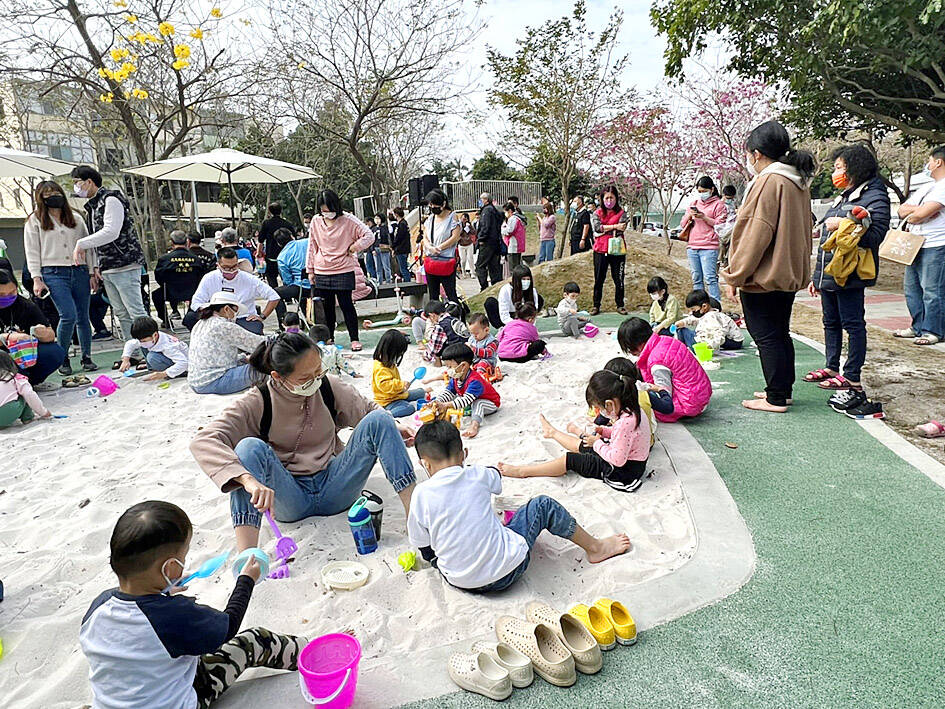Taipei has the highest proportion of residents who have dependents, at more than half last year, data released by the Ministry of the Interior on Monday showed.
It is also where the heaviest financial burden is placed on the “sandwich generation” — those who need to support at least one child and at least one parent.
The “dependency ratio” climbed to more than 50 percent in Taipei for the first time last year, meaning that for every two working-age residents (aged 15 to 64) there is one family dependent, defined as younger than 14 or older than 65.

Photo: Huang Shu-li, Taipei Times
The nation’s aging index is the number of people aged 65 or older divided by the number of people aged 14 and younger, multiplied by 100.
Chiayi County had the highest score in the index last year at 252.45, followed by Keelung at 196.12, Kinmen County at 196.01, Nantou County at 195.74 and Pingtung County at 193.08.
Keelung posted the biggest increase, rising from 184.22 in 2021, while Kinmen recorded the second-biggest increase, followed by Nantou.
In the six special municipalities, Taipei has the highest aging index at 166.1, followed by Kaohsiung at 161.78, while Taoyuan had the lowest score at 101.89.
Taoyuan still trailed Hsinchu City and Hsinchu County, which scored 87.03 and 86.71 respectively. The two regions are the only places in Taiwan where the younger population is bigger than the elderly population.
Regarding families that support elderly parents, Taipei surpassed Chiayi County, with a dependency ratio of 31.44 percent, up from 29.76 percent in 2021. Chiayi County’s ratio was 31.12 percent.
Hsinchu City has the highest dependency ratio for young people at 23.38 percent, followed by Hsinchu County at 22.27 percent and Taoyuan at 19.54 percent.
The lowest financial burden placed on the “sandwich generation” was in Kinmen County and other outlying islands, as they have the most social welfare benefits, subsidies and incentives for residents, ministry officials said.
Many people who are registered as living on outlying islands, work and live on Taiwan’s main island, so their dependency ratio does not reflect the actual situation and cannot be used for comparison, officials said.
House ownership in Taiwan has increased, while there has also been a growth in single-person households, which made up 35 percent of all households nationwide. It is the highest ratio in the nation’s history.
There were 3.22 million single-person households last year, 1.91 million two-person households and 1.64 million three-person households, a record high for all three.
A decade ago, single, two and three-person households totaled 770,000, 340,000 and 150,000 respectively.
Households of four or more people totaled 2.65 million 10 years ago, but dropped to a record low 2.31 million last year, or 25.4 percent of the nation’s total.
The number of four-person households ranged from 1.3 million to 1.34 million throughout most of the past decade, but dropped below 1.3 million in 2020 and plunged to 1.26 million last year.
The average household has 2.56 people living in it, also a record low.
This indicates that the traditional three-generation nuclear family is fast disappearing, officials said, adding that people registered in households might not be related, but the trend shows that the family composition of Taiwan’s population is changing.

Beijing could eventually see a full amphibious invasion of Taiwan as the only "prudent" way to bring about unification, the US Department of Defense said in a newly released annual report to Congress. The Pentagon's "Annual Report to Congress: Military and Security Developments Involving the People's Republic of China 2025," was in many ways similar to last year’s report but reorganized the analysis of the options China has to take over Taiwan. Generally, according to the report, Chinese leaders view the People's Liberation Army's (PLA) capabilities for a Taiwan campaign as improving, but they remain uncertain about its readiness to successfully seize

HORROR STORIES: One victim recounted not realizing they had been stabbed and seeing people bleeding, while another recalled breaking down in tears after fleeing A man on Friday died after he tried to fight the knife-wielding suspect who went on a stabbing spree near two of Taipei’s busiest metro stations, Taipei Mayor Chiang Wan-an (蔣萬安) said. The 57-year-old man, identified by his family name, Yu (余), encountered the suspect at Exit M7 of Taipei Main Station and immediately tried to stop him, but was fatally wounded and later died, Chiang said, calling the incident “heartbreaking.” Yu’s family would receive at least NT$5 million (US$158,584) in compensation through the Taipei Rapid Transit Corp’s (TRTC) insurance coverage, he said after convening an emergency security response meeting yesterday morning. National

Taiwan has overtaken South Korea this year in per capita income for the first time in 23 years, IMF data showed. Per capita income is a nation’s GDP divided by the total population, used to compare average wealth levels across countries. Taiwan also beat Japan this year on per capita income, after surpassing it for the first time last year, US magazine Newsweek reported yesterday. Across Asia, Taiwan ranked fourth for per capita income at US$37,827 this year due to sustained economic growth, the report said. In the top three spots were Singapore, Macau and Hong Kong, it said. South

PLANNED: The suspect visited the crime scene before the killings, seeking information on how to access the roof, and had extensively researched a 2014 stabbing incident The suspect in a stabbing attack that killed three people and injured 11 in Taipei on Friday had planned the assault and set fires at other locations earlier in the day, law enforcement officials said yesterday. National Police Agency (NPA) Director-General Chang Jung-hsin (張榮興) said the suspect, a 27-year-old man named Chang Wen (張文), began the attacks at 3:40pm, first setting off smoke bombs on a road, damaging cars and motorbikes. Earlier, Chang Wen set fire to a rental room where he was staying on Gongyuan Road in Zhongzheng District (中正), Chang Jung-hsin said. The suspect later threw smoke grenades near two exits